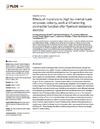Identificador persistente para citar o vincular este elemento:
https://accedacris.ulpgc.es/jspui/handle/10553/69297
| Título: | Effects of moderate vs. high iso-inertial loads on power, velocity, work and hamstring contractile function after flywheel resistance exercise | Autores/as: | Piqueras-Sanchiz, Francisco Martín Rodríguez, Saúl Manuel Martinez-Aranda, Luis Lopes, Thiago Ribeiro Raya-Gonzalez, Javier Garcia-Garcia, Oscar Nakamura, Fabio Yuzo |
Clasificación UNESCO: | 3313 Tecnología e ingeniería mecánicas | Palabras clave: | Human Skeletal-Muscle Eccentric-Overload Measurement Error Neural-Control Leg Stiffness, et al. |
Fecha de publicación: | 2019 | Publicación seriada: | PLoS ONE | Resumen: | Flywheel iso-inertial training has been shown to positively affect muscular strength and sports performance (e. g. agility). However, implementing such eccentrically-biased training during a microcycle needs to be carefully planned due to its purported effects on the neuromuscular system that can last for hours/days post-exercise. This study aimed at using tensiomyography to verify the effects of different inertias during the hip extension exercise on the contractile function of biceps femoris and semitendinosus muscles of the dominant leg for up to 72 hours post-exercise. Thirty participants (24.4 +/- 3.4 years) were divided into 0.075 or 0.1 kg.m(2) inertia groups and a control group. Magnitude-based analysis was used for the comparisons. Several tensiomyography parameters were changed after both intensities of flywheel exercise (in most cases indicating a decrement in muscle stiffness), whereas most between-group differences suggested that in the semitendinosus muscle, the higher inertia (0.1 kg.m(2)) influenced the muscle stiffness parameters more (e.g. Dm = maximal radial displacement) while in the biceps femoris, the greater effect was caused by the lower inertia (0.075 kg.m(2)) (e.g. Tc = contraction time). Most changes in contractile properties of the investigated muscles occur within 24 hours post-exercise, but can persist for up to 72 hours. However, higher inertia (0.1 kg.m(2)) influenced the stiffness of the semitendinosus muscle more, while in the biceps femoris, the greater effect was caused by the lower inertia (0.075 kg.m(2)). These findings should be considered by practitioners when prescribing flywheel iso-inertial training. | URI: | https://accedacris.ulpgc.es/handle/10553/69297 | ISSN: | 1932-6203 | DOI: | 10.1371/journal.pone.0211700 | Fuente: | Plos One[ISSN 1932-6203],v. 14 (2) |
| Colección: | Artículos |
Vista completa
Citas SCOPUSTM
22
actualizado el 08-jun-2025
Citas de WEB OF SCIENCETM
Citations
20
actualizado el 08-jun-2025
Visitas
140
actualizado el 31-may-2025
Descargas
219
actualizado el 31-may-2025
Google ScholarTM
Verifica
Altmetric
Comparte
Exporta metadatos
Los elementos en ULPGC accedaCRIS están protegidos por derechos de autor con todos los derechos reservados, a menos que se indique lo contrario.
